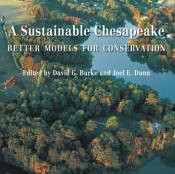Bundled Benefits in Filtering Forests on the Chesapeake Bay
David Burke and Joel Dunn compiled “A Sustainable Chesapeake: Better Models for Conservation” to examine the economic benefits of good environmental stewardship. Complete with examples and analysis, the authors say smarter conservation leads to sustainable economics. One chapter in particular provides fodder for the debate over stacking and bundling.

David Burke and Joel Dunn compiled “A Sustainable Chesapeake: Better Models for Conservation” to examine the economic benefits of good environmental stewardship. Complete with examples and analysis, the authors say smarter conservation leads to sustainable economics. One chapter in particular provides fodder for the debate over stacking and bundling.
4 January 2011 | Late last year, conservation planner David burke teamed up with Joel Dunn, Program Coordinator of The Conservation Fund’s Sustainable Chesapeake initiative, to edit and publish a how-to guide for conservation-finance success called A Sustainable Chesapeake: Better Models for Conservation, which The Conservation Fund has made available as a free download.
They compiled 31 case studies from across the Chesapeake Bay watershed and grouped them into six chapters: Climate Change Solutions, Stream Restoration, Green Infrastructure, Incentive Driven Conservation, Watershed Protection, and Stewardship. Each chapter is introduced with a summary of the restoration principles learned from the projects, and each case study contains photographs, references, and contact information.
You can download the entire publication as one 278-page pdf document, or you can download the chapters individually.
The fifth chapter covers watershed protection, and one case study in particular – Earning Multiple Credits for a Forested Riparian Buffer – is particularly timely given the thorny debate over how and whether to bundle multiple ecosystem values on one piece of land.
Specifically, it examines the impact of a $61,000 grant that Exelon Corporation provided in 2006 to the Pennsylvania Environmental Council to develop a demonstration project on local farmland owned by Lancaster General Health. The Pennsylvania Environmental Council agreed to provide quality assurance and control the property. Exelon Corporation, in turn, is slated to benefit by selling environmental credits in the restored site.
The editors describe methods the Pennsylvania Environmental Council and the Exelon Corporation used to co-develop a 1,100-foot riparian buffer to absorb pollutants before they flowed from farmland into an adjacent stream. To ensure the buffer’s long-term preservation they secured a 25-year conservation easement. The restored buffer can be used as a mitigation bank that sells credits to developers as compensation for environmental damage done elsewhere. These payments could be significant.
The contract allows Exelon Corporation to receive multiple credits from multiple sources. In exchange for the buffer’s restored ability to absorb the nutrients that pollute waterways, for example, Exelon Corporation can receive nutrient-reduction credits from Pennsylvania’s nutrient trading program. And since the buffer can also absorb carbon that causes global warming, Exelon Corporation can receive carbon sequestration credit from the U.S. Department of Energy.
Through political leverage the project is also yielding unforeseen and additional positive economic and environmental results, the editors write. Lancaster County Commissioners recently announced their decision to build a county morgue and crime lab on two of the six acres owned by the Lancaster General Health, including land preserved by the demonstration project as riparian buffer. A local coalition of project partners is working with Lancaster General Health to replace trees lost if development impacts the riparian buffer. They also plan to use low-impact development techniques to mitigate potential runoff that could occur during construction.
Better still, the local township, East Hempfield, recently financed a $34 million bond issue that, in addition to funding the new morgue, provides substantial funding to the county’s farmland preservation and urban enhancement grant programs.
Through real-world examples such as the Lancaster General Health project, The Conservation Fund’s A Sustainable Chesapeake: Better Models for Conservation provides a nuts-and–bolts analysis of how nitrogen nutrient reduction, riparian ecosystem restoration, carbon sequestration, and no-till farmland credits can be overlaid to financially benefit landowners while providing legal leverage and a significant funding stream for farmland preservation.
Additional resources
Please see our Reprint Guidelines for details on republishing our articles.

